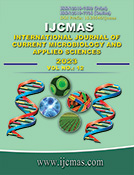


 National Academy of Agricultural Sciences (NAAS)
National Academy of Agricultural Sciences (NAAS)

|
PRINT ISSN : 2319-7692
Online ISSN : 2319-7706 Issues : 12 per year Publisher : Excellent Publishers Email : editorijcmas@gmail.com / submit@ijcmas.com Editor-in-chief: Dr.M.Prakash Index Copernicus ICV 2018: 95.39 NAAS RATING 2020: 5.38 |
Nephrolithiasis associated with infected renal calculi act as foci of persistent infection of the urinary tract and development of multidrug resistance representing a significant cause of morbidity and mortality and may not be detected by urine culture alone. This prospective study included 63 patients diagnosed with renal calculi who underwent Percutaneous nephrolithotomy (PCNL) in Tertiary Health Care Centre, to determine the bacteriology and antibiotic sensitivity patterns of pre-operative midstream urine and postoperative stone culture and to study bacterial association between the two cultures and to assess which is a better indicator in establishing urinary tract infection. Out of 63 study subjects, 22 (34.92%) had urine cultures positive and 27 subjects (42.86%) had positive stone cultures. Out of 27 stone culture positive patients, 9 (33.3%) had their urine samples sterile. Out of 22 urine culture positive patients, 4 (18.18%) were negative for stone culture. 13/18 (72.2%) cases revealed concordant growth in both the cultures. Urine culture revealed Escherichia coli to be the predominant pathogen whereas postoperative stone analysis revealed Pseudomonas species to be predominant. The bacterial isolates were found to be most sensitive to imipenem, piperacillin/tazobactum, nitrofurantoin, cefaperazone and amikacin. Multidrug resistance was found to be present in 41.67% and 51.85% of the bacterial isolates from urine and stone culture respectively. In the present study determined renal stone culture to be more sensitive than urine culture in identifying the etiological agents of urinary tract infection along with their antibiotic susceptibility patterns to serve as guide for appropriate therapy.
 |
 |
 |
 |
 |